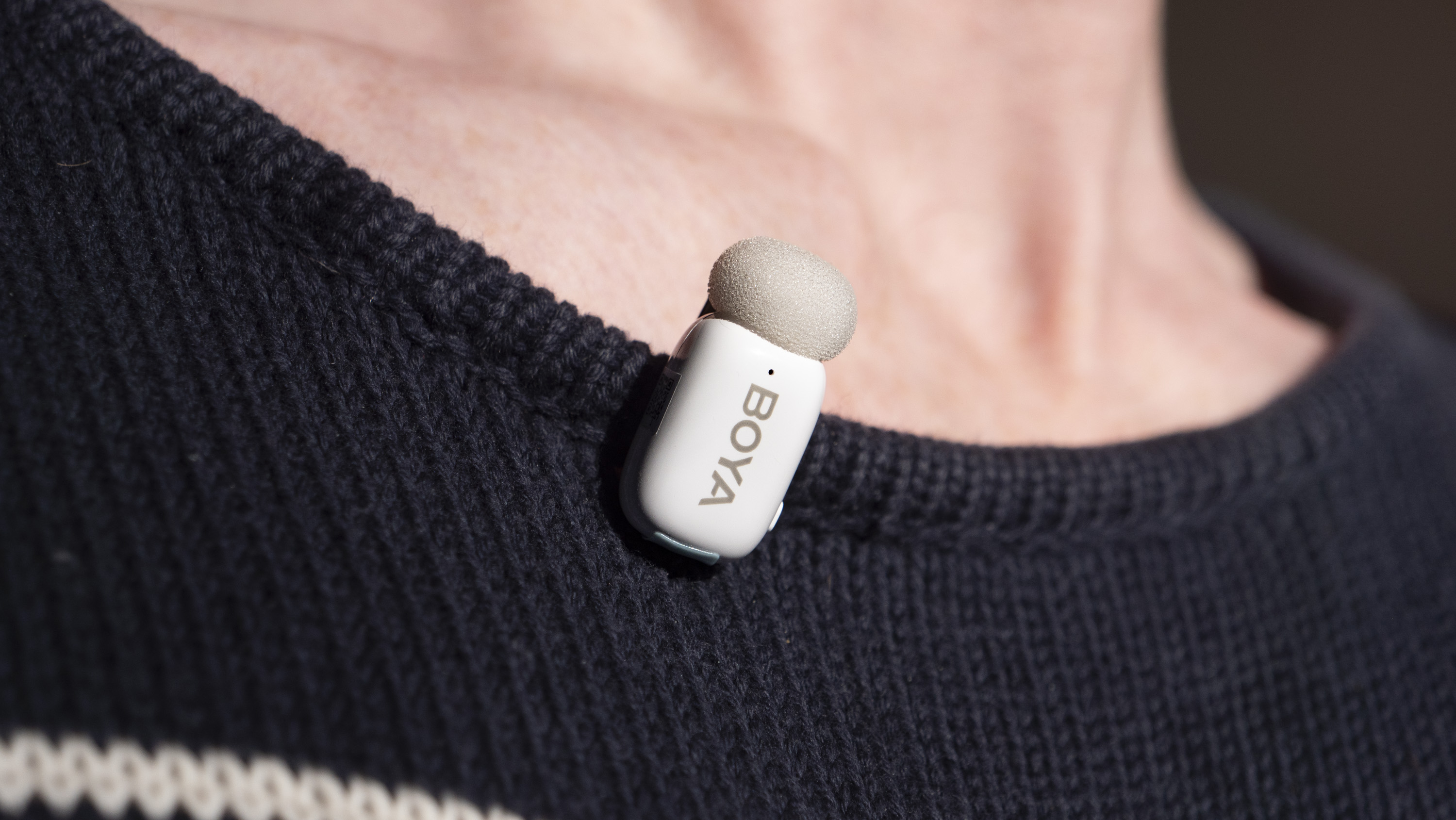TechRadar Verdict
New wireless mics for content creators continue to flood the market, but that doesn't stop the Boya Mini standing out from the crowd, chiefly because of its aggressive pricing. At less than half the price of leading alternatives such as the DJI Mic Mini and Rode Wireless Micro, it's an excellent first wireless mic, and the compromises for that price tag, namely its lesser 16-bit audio quality and plasticky components, are acceptable. It connects reliably, and has decent battery life and a discreet design, while its audio features ensure it punches above its 16-bit audio weight, making it an excellent first wireless mic for those on a shoestring.
Pros
- +
Reliable, and quick startup
- +
Super-tiny mic and receiver
- +
All components pack away into charging case
Cons
- -
Only 16-bit audio
- -
Cheapish build quality
- -
No audio monitoring
- -
No option for 3.5mm connection with cameras
Why you can trust TechRadar
Boya Mini: one-minute review
Beginner content creators on a shoestring budget who are looking to up their audio quality will struggle to find better value than that offered by the Boya Mini wireless mic. For less than half the price of leading models like the DJI Mic Mini you get a reliable twin-mic kit, and while the 16-bit audio is admittedly modest, it's quality is perfectly acceptable for the likes of TikTok and Youtube Reels.
Naturally, for such a low price, there are a few compromises; build quality is so-so, there's no option for a 3.5mm connection (just USB-C or Lightning, which counts out most dedicated cameras), nor is there audio monitoring of any kind, or manual control over levels. This is a simple plug-and-go mic that, much like the Rode Wireless Micro, is designed for smartphones, laptops, or even the DJI Osmo Pocket 3 – basically any USB-C device. And for such users, the Boya Mini's simplicity works a treat.
The mics are super-tiny and weigh just 5g, so they don't tug on clothing. The receiver is also tiny, which means it doesn't get in the way when connected to your phone's charging port. I've found the mics quick to connect and reliable time and again, while the audio quality for vlogging is perfectly acceptable, and certainly much better than a phone's built-in mic. The fact that noise reduction features is a nice bonus too. If you're looking for a no-frills, reliable and cheap wireless mic, the Boya Mini is an easy recommendation.
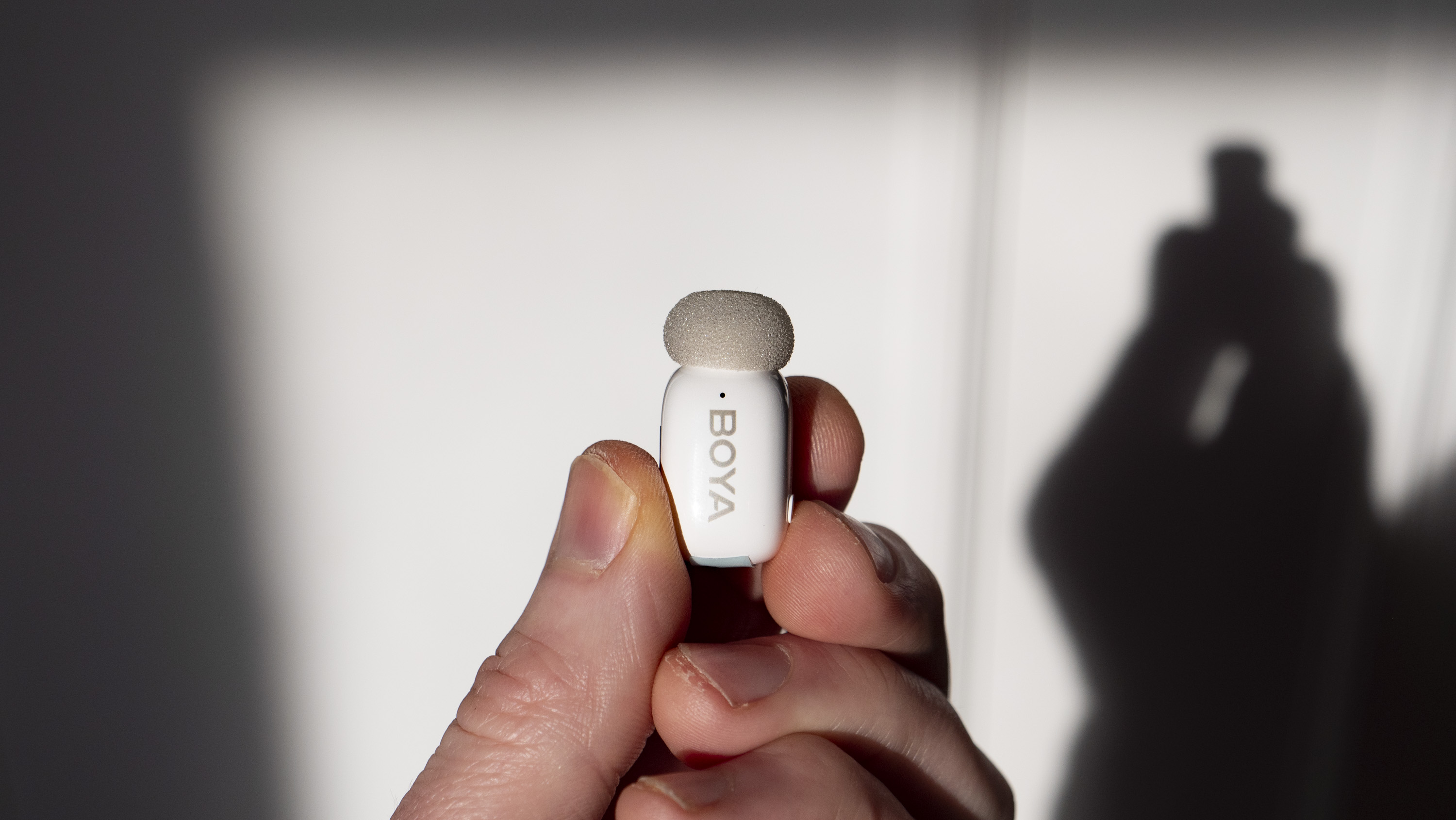
Boya Mini: price and release date
- Prices start at $45 / £52.99 / AU$83 for kits with charging case
- Available in kits with USB-C and / or Lightning adaptors
- Available now, in black or white finishes
The Boya Mini's list price is $45 / £52.99 / AU$83 at Amazon for the twin mic kit with charging case and USB-C connector. The kit is also available with Lightning connector instead, or in some regions for $59.99 / £69.99 with both connectors; or you can save money by opting for just a single mic and receiver kit. Should you click through to the Boya website, then you get redirected to a discount site where the price is even lower.
The mics feature clip-on foam covers, and all the components fit inside the charging case, while a soft case is also included. For the money, you'll struggle to find a better-value wireless mic.
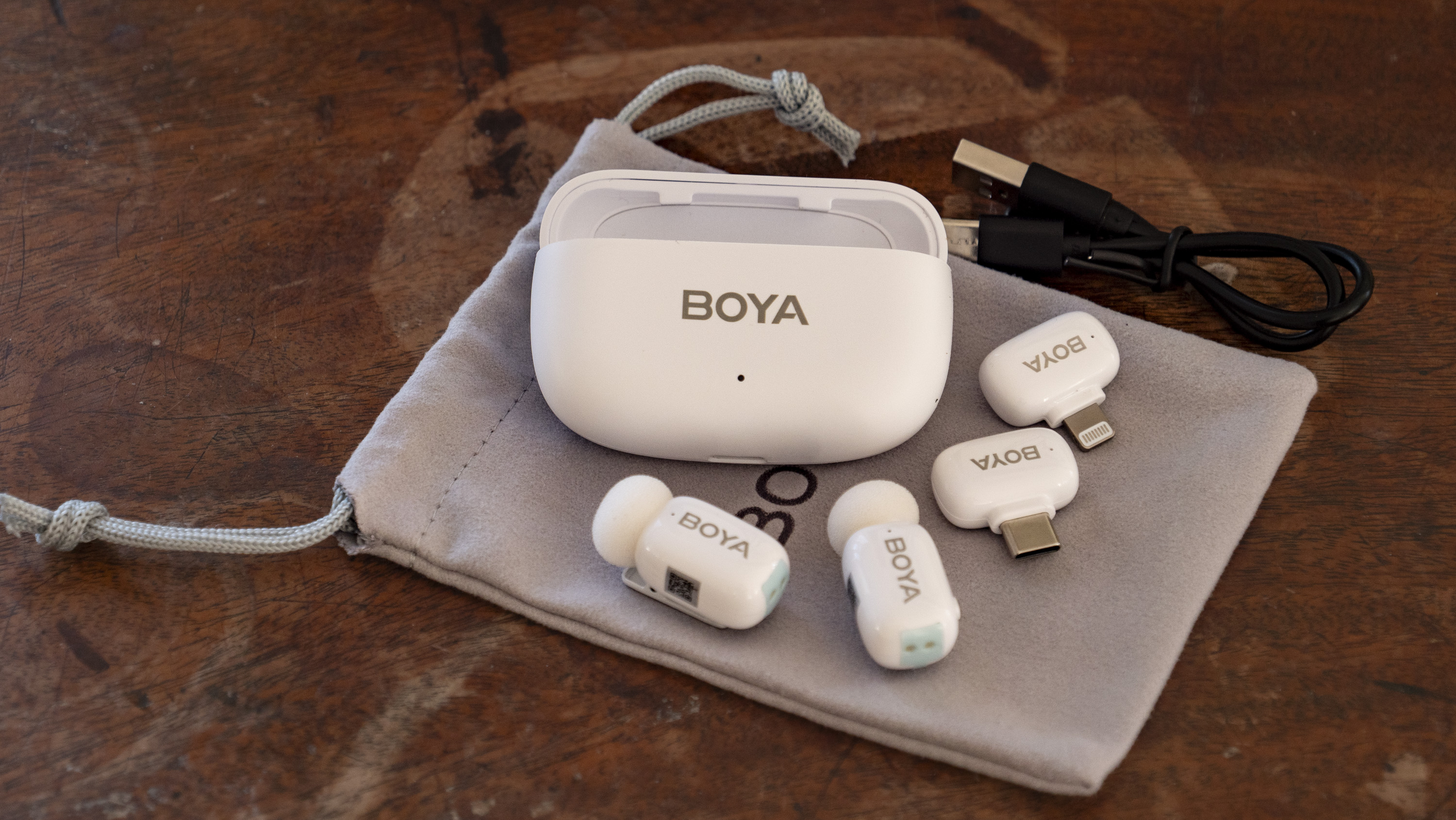
Boya Mini: specs
| Dimensions | Transmitter: 31 x 15 x 16.4mm (L x W x H) Charging case: 67.4 x 48.4 x 22.5mm (L x W x H) |
| Weight | 5g (transmitter), 29g (charging case) |
| Transmission range | 100m |
| Connectivity | Receiver: USB-C or Lightning |
| Battery | 6 hours, plus four additional charges from the case |
| Audio | 16-bit |
| Noise cancelling | Yes, one-click |
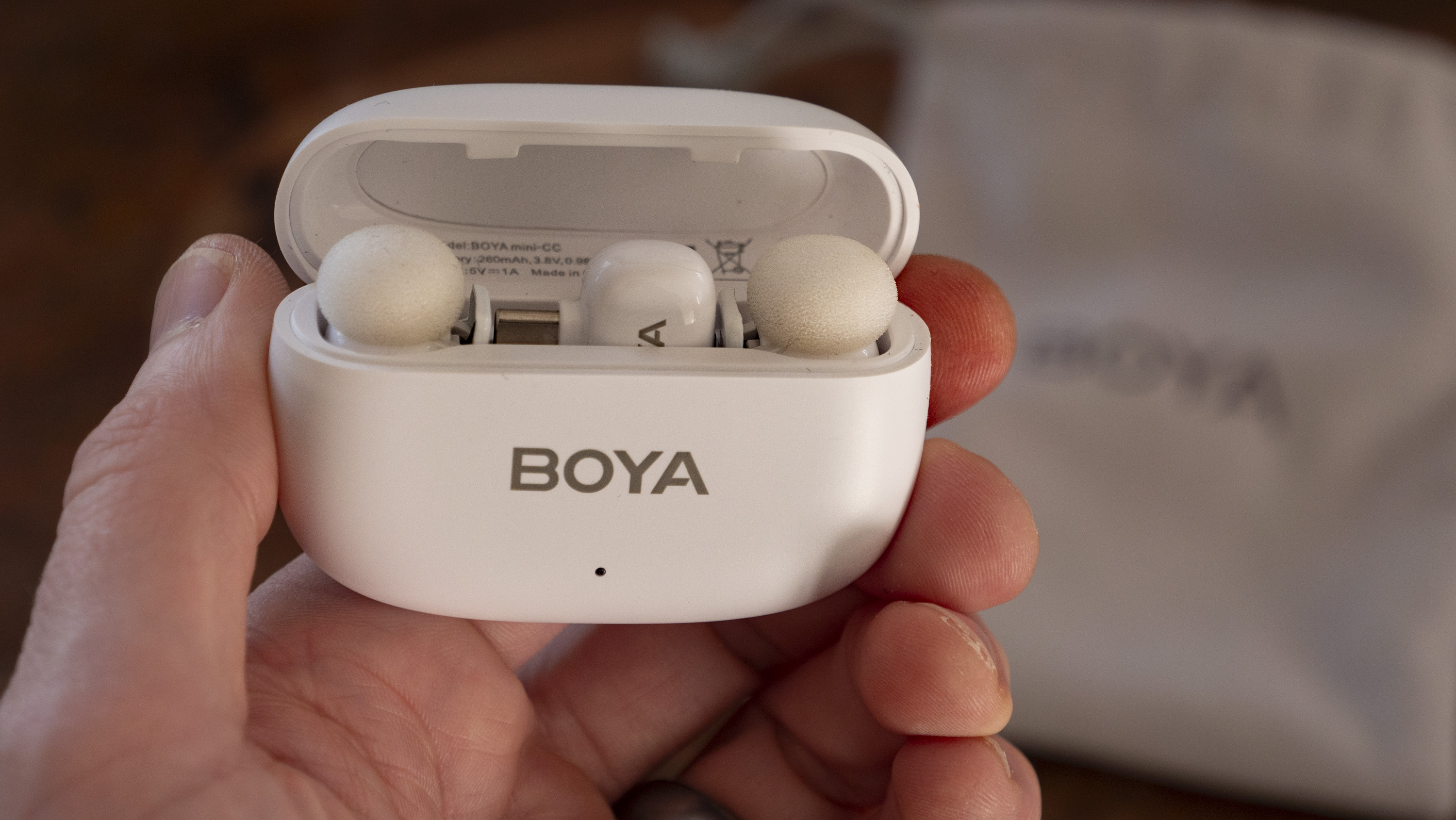
Boya Mini: Design
- World's smallest and lightest wireless mic, weighing just 5g
- Components are available in black or white finishes
- Tiny receiver, available in USB-C or Lightning versions
'Mini' is doing a slight disservice to the Boya Mini wireless mic kit – It's billed as the world's tiniest wireless microphone, measuring just 31 x 15 x 16.4mm. And given that it weighs just 5g, it might just be the lightest of its kind too.
Such miniscule proportions are handy in two ways; the mics are discreet, and nor do they tug on clothing. The mics are clip-on only, unlike pricier rivals that feature versatile through-clothing magnetic mounting. That means you need to find an edge in clothing, like a collar or pocket or button hole to attach the mic to.
The clip is metal, so if you source your own magnet you could fix the Boya Mini magnetically through clothing. The only reason I can think of why Boya didn't include magnets in the kit is that the mic and its clip are so small that it wouldn't be possible to securely fix it to clothing that way.
Build quality of the Boya Mini's components is so-so, and over the month or so testing the gear I've been conscious to treat it with care, especially the mic's clip, which is small enough to struggle to gain a secure hold on thicker clothing.
I was using the Rode Wireless Micro alongside the Boya Mini, and there's an obvious gulf in build quality – the pricier Rode model looks and feels the business.
As mentioned, you can buy the Boya Mini as a complete kit which comprises two transmitters (mics), a receiver (you choose which type you need – USB-C, Lightning or both) and a charging case.
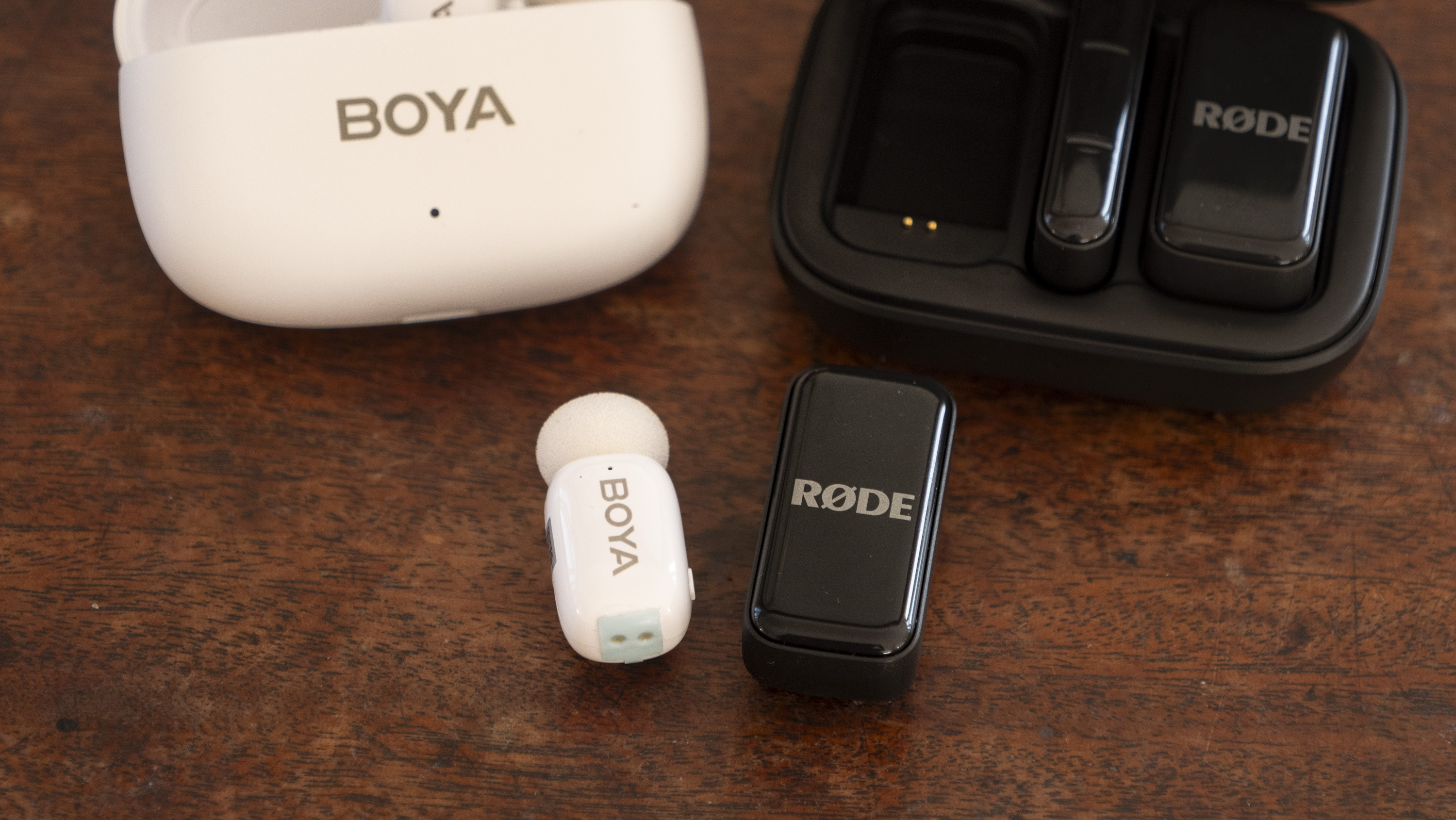
The mics utilize clip-on foam covers to dampen audio that, handily, can remain in position on the mics and the components will still fit into the charging case. The Rode Wireless Micro comes with clip-on wind muffs, but these don't fit it in the case so, you'll have to find somewhere else to stow them when not in use. Boya has the practical advantage here.
Like the mics, the receiver is super-tiny. It attaches to your phone, laptop or tablet's charging port, and you'll barely notice it's there while filming. You need the receiver for the mics to work because, unlike the DJI Mic Mini, they don't feature Bluetooth connectivity.
If you're a wireless mic first-timer, you'll be up and running with mic'd audio in no time at all. Once you attach the receiver and select the video option in your camera app, you should get a prompt to select the wired mic option in the settings menu (rather than the phone's built-in mic) – that's my experience using a Pixel 8 Pro. Then you're good to go.
The whole process from unboxing to getting started is as easy as can be, and consistently reliable. It might be cheap, but it's certainly worth it.
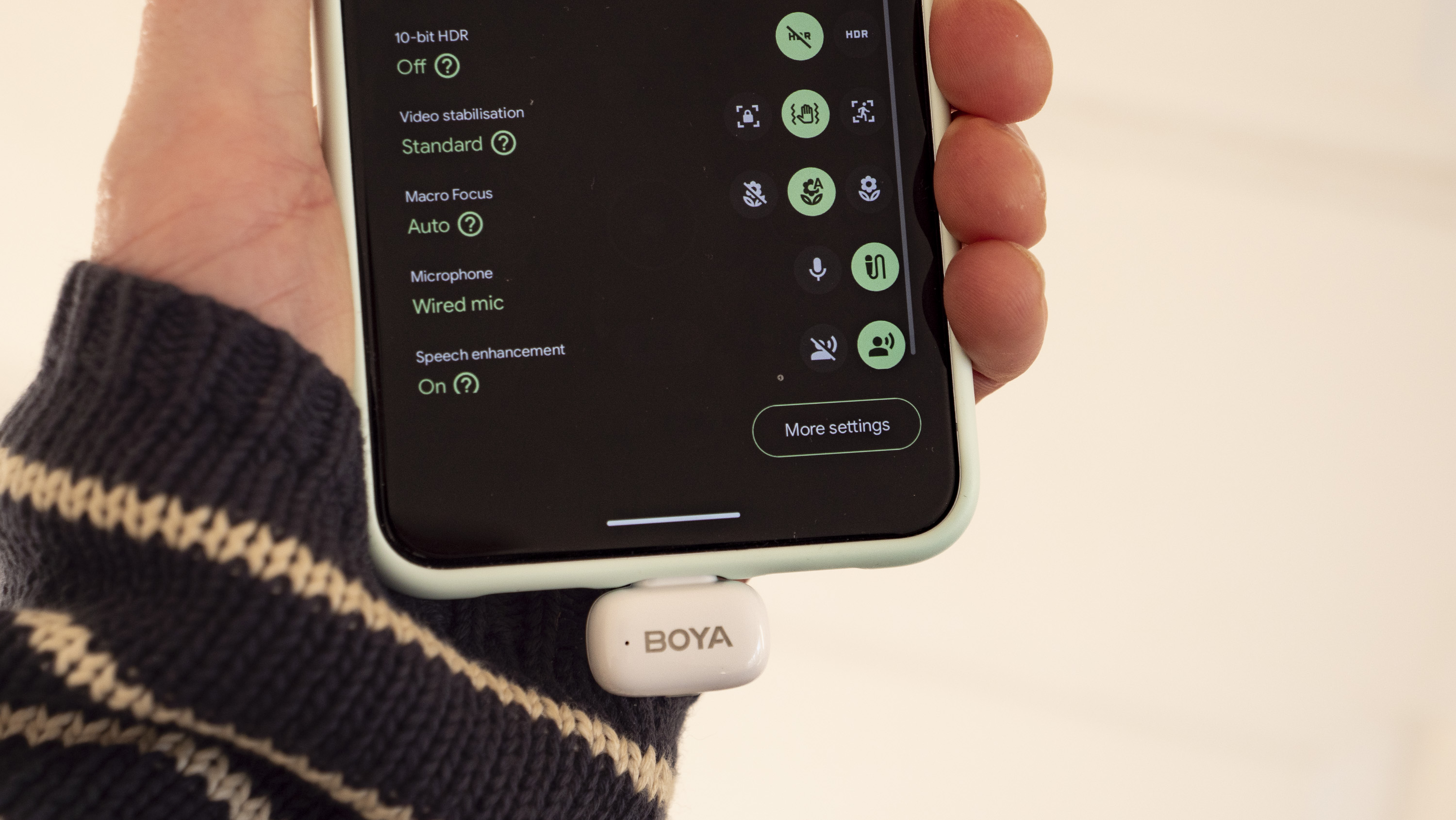
Boya Mini: Performance
- Transmission range up to 100m
- 6 hours operating time, with an additional four charges from the charging case
- Three-level noise cancellation, plus a gimmicky Human Voice Enhancement mode
Despite its tiny size, battery life is practically on a par with bulkier, pricier alternatives. You get up to six hours record time per mic, and Boya says the charging case with its 260mAh battery provides additional charges that total 30 hours record time. That's enough juice for several days of moderate vlogging.
Transmission range is rated up to 100m in clear sight. I haven't personally tested the limits of the Boya Mini's transmission range, but I can vouch for the stability of the connection when vlogging. Note, you'll get interference at a much closer proximity than 100m if your device and the mic lose line of site, for example if you turn your back to the camera.
Where the Boya Mini most obviously comes up short as a cheap wireless mic is that audio bit-depth maxes out at 16-bit, and output is mono only. Splash out thrice the cash on a leading alternative, and you'll be getting richer 24-bit audio with the option for stereo output. Oh, and there's no low-cut filter, either, so low frequencies such as the hum of an air conditioner aren't filtered out.
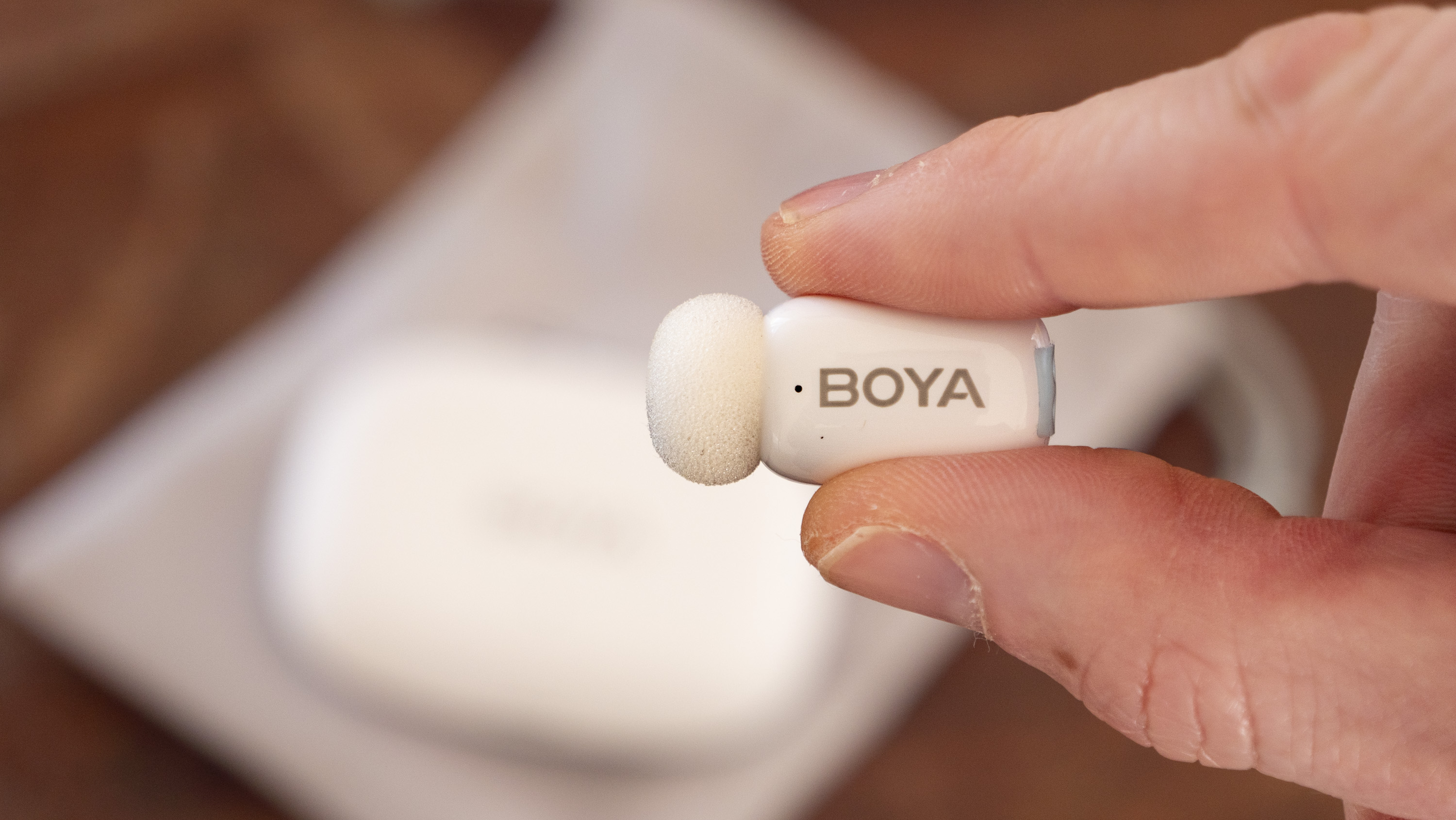
No low-cut filter isn't a big deal, though – the Boya Mini features one-click noise cancellation, activated through the one physical button on the mic. There are three levels of strength, though honestly I didn't notice a huge difference in any of the settings. You'll know when noise cancellation is active because the blue light on the receiver that indicates an active connection turns green.
There's also Boya's version of voice enhancement, which sounds impressive but don't be fooled – it's a gimmick. Think of it as voice distortion – one setting makes your voice deep, one high-pitched, and one normal. It might be a fun feature to play with once or twice for the laughs, but that's the extent of it.
So what do I make of the audio quality of the Boya Mini? I think the maximum possible quality has been squeezed out of its humble hardware.
If you're a casual vlogger, and need clear and crisp vocals across a range of scenarios, you'll get that with the Boya Mini. It lacks the finesse of a 24-bit alternative, but it certainly is a mark-up from your smartphone's mic. In fact, I've been happy enough with the quality that I've mic'd up with the Boya Mini for a few videos that I've shot for TechRadar's TikTok channel.
It's also versatile in that you can use it easily with a camera like the Osmo Pocket 3 (especially given how small the receiver is), with a laptop for work calls, and yes, with your smartphone for shooting Youtube, TikTok and Instagram content.
I'd be remiss not to address the technically-minded, so here are a few of the mics audio specs: it has a 20Hz to 20kHz frequency range, a maximum 120db SPL, and a 80db signal-to-noise ratio. Those are solid specs for such a cheap device.
Should I buy the Boya Mini?
Buy it if…
You want the cheapest possible wireless mic that's worth buying
It might be mega cheap, but the Boya Mini is also the real deal, with decent-quality audio and reliable performance.
You're a beginner smartphone content creator
The Boya Mini is primarily designed for use with smartphones, while its quality and automated audio features are sufficient for beginners.
You want a tiny wireless mic
Billed as the world's smallest and lightest wireless mic, the Boya Mini is positively tiny and discreet, and available in black or white version.
Don’t buy it if…
You'll eventually need a mic for cameras
The Boya Mini lacks a 3.5mm connector, meaning that you wont be able to use it with a dedicated camera, unlike the DJI Mic Mini.
You'll likely want audio-level monitoring and gain control
Its simple and therefore restricted in some ways – you can't easily monitor audio levels while recording for peace of mind, as you can with pricier alternatives like the DJI Mic 2.
You want the best possible audio quality
The Boya Mini punches above its weight, but it's not one for audiophiles, who will prefer the richer audio quality of pricier rivals.
Boya Mini: also consider
| Header Cell - Column 0 | Boya Mini | Rode Wireless Micro | DJI Mic Mini |
|---|---|---|---|
| Dimension | Transmitter: 31 × 15 × 16.4 mm (L x W x H) Charging case: 67.4 × 48.4 × 22.5 mm (L x W x H) | Transmitter: 40 x 27 x 17mm (L x W x H)Receiver: 44 x 24 x 9mm (L x W x H) | Transmitter: 26.6 x 26.1 x 16mm (L x W x H)Receiver: 46.5 x 29.6 x 19.3mm (L x W x H) |
| Weight | 5g (transmitter), 29g (charging case) | 12g (transmitter, without magnet), 102g for the whole kit | 10g (transmitter, without magnet) |
| Transmission range | 100m | 100m | 400m |
| Connectivity | Receiver: USB-C or Lightning | Receiver: USB-C or Lightning | Receiver: USB-C or Lightning, 3.5mm jack |
| Battery | 6 hours, plus four additional charges from the case | 7 hours (plus two additional charges from the fully charged case for a total of 21 hours) | 11.5 hours (transmitter), 10.5 hours (receiver), up to 48 hours with fully charged case |
| Audio | 16-bit | 24-bit | 24-bit (drops to 16-bit via Bluetooth) |
| Noise cancelling | Yes, one-click | No | Two-level, auto |
| Bluetooth | No | No | Yes |
Rode Wireless Micro
Our favorite wireless mic primarily designed for smartphones is the Rode Wireless Micro. It's more than twice the price of the Boya Mini and has superior 24-bit audio quality, plus Intelligent Gain Assist for clear vocals, and impressive build quality. However, it doesn't include noise cancellation, and the mics themselves are a little bulkier.
Read our Rode Wireless Micro in-depth review
DJI Mic Mini
A premium and versatile alternative, the Mic Mini features 24-bit audio and Bluetooth connectivity, meaning you can bypass the receiver altogether, plus a 3.5mm connector for use with cameras. You can also dial in audio levels manually using the receiver. However, the Mic Mini feels more designed for both phones and cameras, with a bulkier receiver better designed for cameras.
Read our DJI Mic Mini review
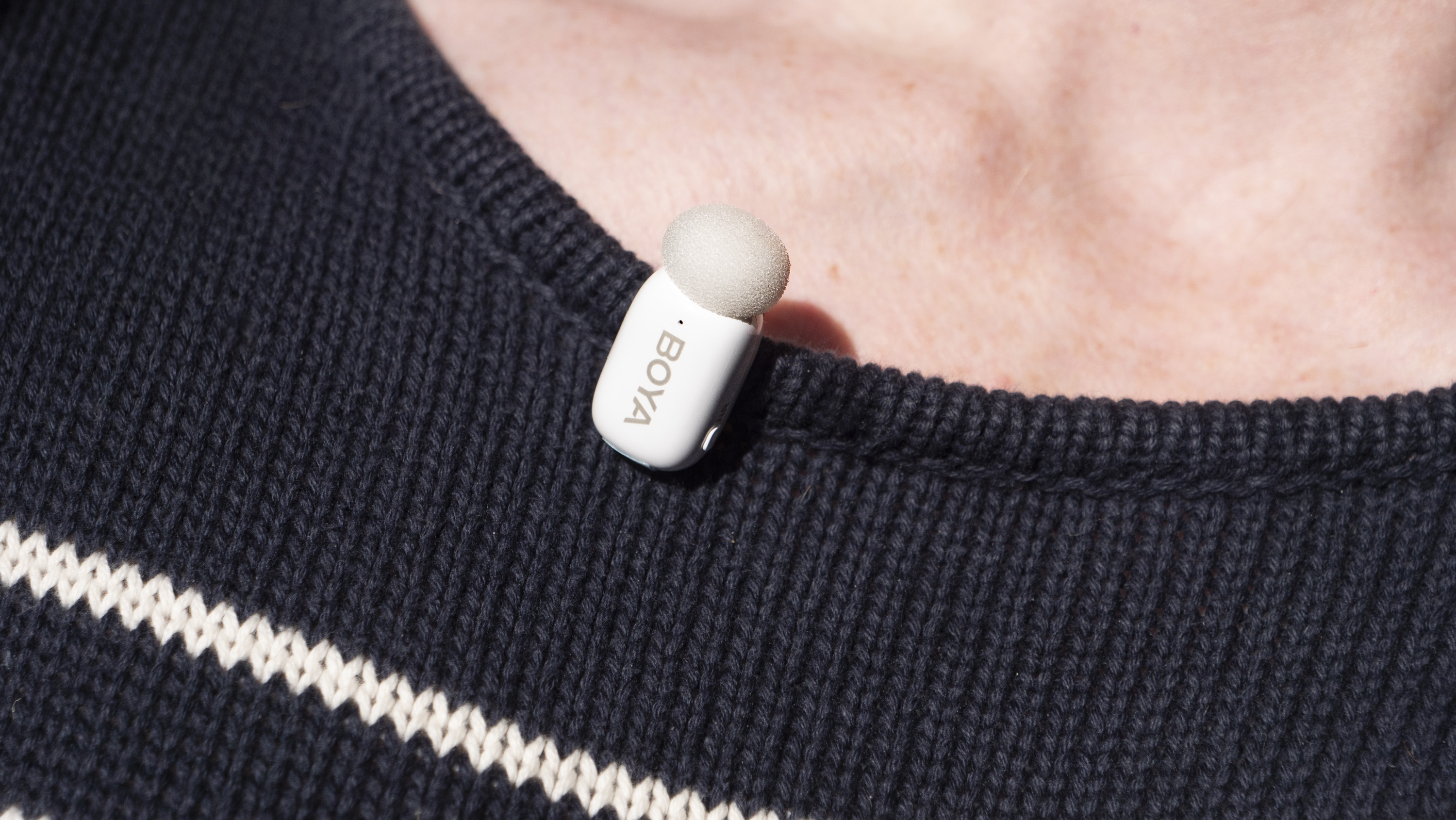
How I tested the Boya Mini
- I had the complete kit with charging case, plus USB-C and Lightning connectors
- I used it regularly for a variety of vlogs for over a month
- Tested alongside the rival Rode Wireless Micro
- Paired primarily with a Google Pixel 8 Pro
With its automated audio recording plus one-click noise reduction and voice enhancement features, there's not a lot to get your head around, and that's the beauty of simple wireless mics like the Boya Mini.
I had the complete kit with charging case, and found the kit to be completely reliable, with the receiver connecting securely to my Pixel 8 Pro phone. I drained the battery of the mic and recharged it through the charging case to test the battery life.
I tested audio quality in a range of scenarios, both indoors and outdoors, and in quiet and noisy environments. I ran comparison tests with the Rode Wireless Micro.
- First reviewed: January 2025
- Read more about how we test

Tim is the Cameras editor at TechRadar. He has enjoyed more than 15 years in the photo video industry with most of those in the world of tech journalism. During his time as Deputy Technical Editor with Amateur Photographer, as a freelancer and consequently editor at Tech Radar, Tim has developed a deeply technical knowledge and practical experience with cameras, educating others through news, reviews and features. He’s also worked in video production for Studio 44 with clients including Canon, and volunteers his spare time to consult a non-profit, diverse stories team based in Nairobi. Tim is curious, a keen creative, avid footballer and runner, and moderate flat white drinker who has lived in Kenya and believes we have much to enjoy and learn from each other.
You must confirm your public display name before commenting
Please logout and then login again, you will then be prompted to enter your display name.
